3 December, 2017
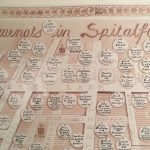
The Migration Museum Project is blessed with a large team of fantastic volunteers, without whom we would find it hard to function and impossible to run our events and exhibitions. Assunta Nicolini is one such volunteer, and her discussions with visitors to our current exhibition, No Turning Back, have got her thinking about a number of issues that she feels are raised by the display. This blog is the result of her thoughts and discussions around two of the seven moments of the exhibition: the arrival in this country of Huguenot refugees after 1685, and the passing of the Aliens Act in 1905.
No Turning Back: Seven migration moments that changed Britain introduces visitors to powerful artworks and archive images carefully interwoven to create a narrative that brings together past and present. It is within history that we so often find the key to understanding many of the social realities we inhabit today.
Migration is no exception. One of the seven moments shown in the exhibition, the year 1685, holds a particular relevance in the understanding of today’s migration dynamics.It was the year that France made Protestantism illegal, precipitating the arrival in Britain of about 50,000 French Protestant Huguenots. Centuries before the drafting of the Refugee Convention (1951), and with no legal framework in place establishing roles and responsibilities towards people escaping persecution, the term ‘refugee’ was introduced into the English language through the French Huguenots arriving on British soil in search of protection (refuge). It took about three centuries, a series of major humanitarian crises and, ultimately, the horror of the Holocaust for the international community to establish a legal framework aimed at giving protection to people fleeing persecution.
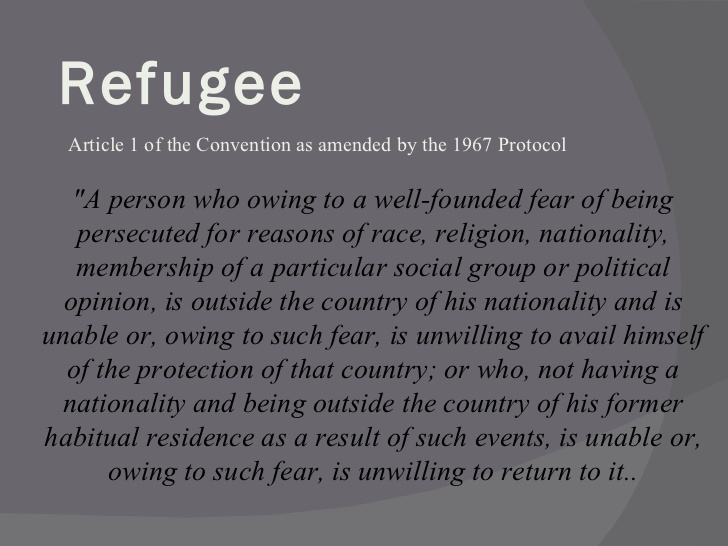
Article 1 of the United Nations’ 1951 Convention Relating to the Status of Refugees.
The history of the Huguenots in Britain is not, however, just about one of the largest refugee groups to seek safety and protection in this country. Their life experiences were not simply defined by their ‘refugee-ness’; on the contrary, their arrival and settlement offer just as important insights into the realities of migration.
In the exhibition, Adam Dant’s delightful map representing this historical moment takes the curious eye of the visitor through a detailed drawing of the streets surrounding East London’s Spitalfields Market. Surnames of French origin are circled to indicate where the Huguenots were to be found. As visitors adjust their eye to these several locations, they then notice a further, more crucial detail. Surnames are accompanied by ‘professions’, mainly artisanal, such as weavers, clockmakers and silk merchants.
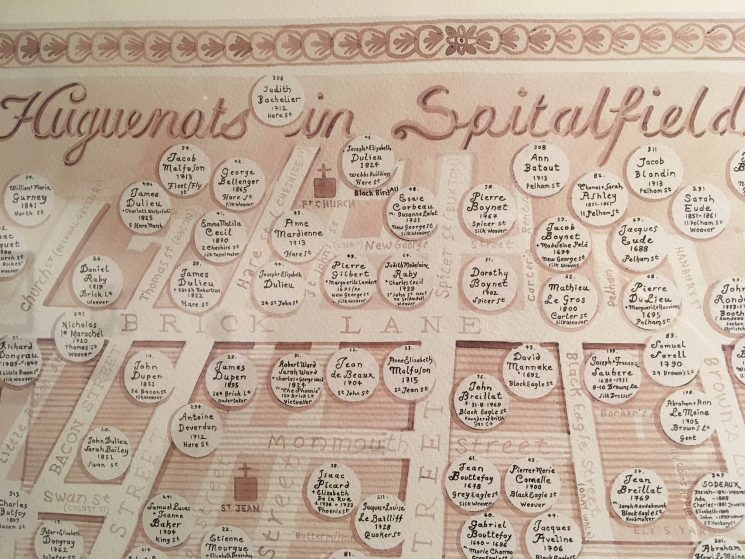
A detail from Adam Dant’s ‘Huguenots in Spitalfields’. A range of professions are readable in these circles, for example: ‘silk weaver’, ‘undertaker’, ‘victuailler’, ‘reed maker’ and ‘gent’. © Adam Dant
Such detail is crucial as it allows the visitor to expand their understanding of who these people were, beyond the one-dimensionality of their ‘refugee-ness’. Being given protection in Britain was not the end of the Huguenots’ ‘migration journey’ – settling and restarting their lives, as well as providing for their families, was just as important. Historical archives tell us that, although the Huguenots left France clandestinely and at short notice, taking little with them and with limited time for planning ahead, they were nevertheless aware that certain destinations were better than others. London, for example, offered not only protection but also great opportunities for employment and hence a better place to settle.
You don’t need to be an expert to spot the striking similarities with contemporary experiences of migration. Today’s refugees are no different from those of centuries ago – like them, they are human beings who, in order to have a life beyond survival, need to work. Obvious though this point is, the current obsession in the media and parliament is the apparent distinction between ‘refugee’ and ‘economic migrant’.
It is possible, however, to make such complexity simple, and to offer an accessible understanding of such migration dynamics. Migration experts have been drawing attention to the fact that immigration statuses – the classification of refugee, migrant or asylum seeker, for example – are never fixed but on the contrary are dynamic and mobile.1 Rigid legal categories labelling individuals either as migrants or refugees have become increasingly obsolete, as they fail to reflect the personal and global realities of contemporary migration.2 The stories of refugee-migrants themselves consistently show that people might start their journey as refugees but, like the Huguenots, become economic migrants later on. Scholars have widely recognised that contemporary migration is defined by its mixed nature and by continuity, rather than an opposition between forced and voluntary migration (see this video for Dr Nicholas van Hear’s clear outline of this matter).
The overlapping and mobility between immigration statuses is an aspect that was overlooked at the the time the Refugee Convention was drafted. Understandably, soon after the Second World War, the concern of the international community was focused predominantly on making sure that persecuted people would be protected outside their home countries. Economic migrants, on the other hand, could not benefit from a specific legal framework protecting their rights, since the ‘voluntary’ dimension of their migration implied they took responsibility for their own protection.
In recent decades, however, a greater emphasis has been placed on additional legal frameworks aimed at correcting the shortcomings of the Refugee Convention, in particular those based on International Human Rights law. A rights-based approach can in fact not only provide a framework for the protection of economic migrants but also enhance refugees’ protection, while at the same time establishing the universal human right to seek asylum.
Despite the availability of different legal frameworks governing migration and ‘refugee-ness’ today, there is no agreed position in policy making, advocacy and public opinion. Public opinion is characterised by narratives of ‘good and bad’ refugee-migrants, of ‘deserving and undeserving protection’, and of ‘inclusion and exclusion’. Refugees are mostly perceived as victims, but the moment they display willingness to economically improve their lives they are automatically seen as economic migrants and hence as undeserving of protection and support.
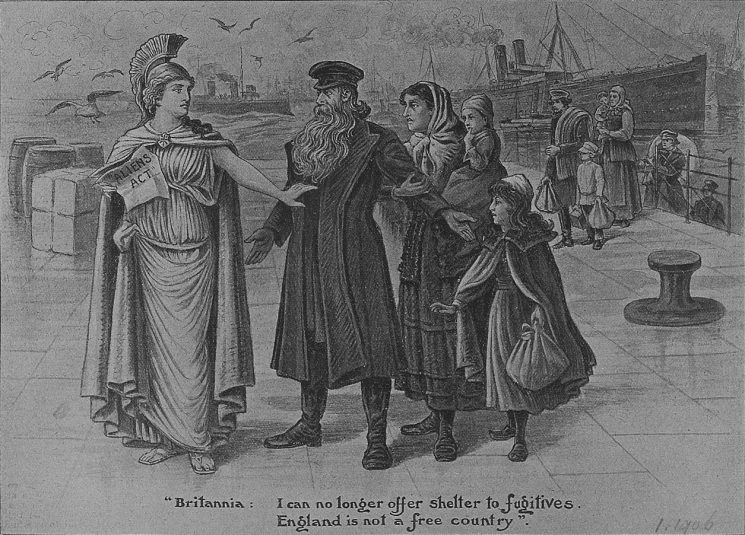
Satire on the Aliens Act – drawing of Britannia turning away a group of refugees who have just disembarked at a port, 1906. Part of the Migration Museum Project’s ‘No Turning Back’ exhibition. Image courtesy of the Jewish Museum.
Far from being new, this narrative partly finds its roots in another pivotal migration moment shown in the exhibition – 1905, when the Aliens Act was passed in Britain, the first legal framework regulating migration and based on the notion of ‘desirable’ and ‘undesirable’ immigrants. The Aliens Act was the result of rising nationalism based on disproportionate fear about newly arrived refugees, mainly Jews, and migrants of Asian origins. A satirical drawing from the time, showing Britannia saying ‘I can no longer offer shelter to fugitives; England is not a free country’, aptly describes the feeling of rejection felt by Jewish refugees. Another pamphlet from the archives directs the visitor’s attention to the fact that rejection was felt not only by refugees but also by immigrants, with trade unions attempting to dismantle the unfounded belief that migrants were competitors in the job market and bad for the British economy. Through the various details of this migration moment, the visitor is also encouraged to think about the importance of keeping labour migration channels open to refugees today.
History reminds us that looking at migration through rigid binaries of ‘desirable’ and ‘undesirable’, ‘deserving’ and ‘economic’, risks reinforcing a dangerous divide that often underpins much of public opinion and policy making. What we witness today and the stories that migrants and refugees tell us bear a profound resemblance to the past and urge us to consider that a refugee-migrant should not be seen as a threat but rather as an asset to Britain and host countries in general.
1 See, for example, Schuster, L (2005) ‘The Continuing Mobility of Migrants in Italy: Shifting between Statuses and Places’. Oxford: COMPAS and Bloch (2011)
2 Zetter, R (2007) ‘More labels, fewer refugees: remaking the refugee label in an era of globalisation’, Journal of Refugee Studies, Volume 20, Issue 2, 1 June 2007, 172–192, https://doi.org/10.1093/jrs/fem011
3 August, 2016
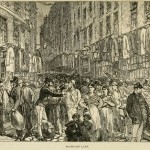
What was the attitude of the Victorians to immigration, particularly Jewish immigration? What was the mood of the country leading up to the passing of the Aliens Act in 1905? And what parallels are there between the experience of immigrants then and now, one hundred years later? The focus of this guest blog is Israel Zangwill and his late-19th-century book Children of the Ghetto; Nadia Valman, who has created an app that allows people to explore the Spitalfields area through the medium of the book, flags up a surprising number of parallels between the two periods.
Children of the ghetto
Israel Zangwill’s 1892 novel Children of the Ghetto is a landmark publication in English literature: the first Victorian novel to offer an insider’s perspective on immigrant lives in London. It offered the reader a wide social panorama, including rabbis, schoolteachers and philanthropists, garment workshop bosses and machinists, socialist organisers and poets, immigrant parents and English-born children. Published to great acclaim at a time of rising popular feeling against immigration, the novel aimed to make a significant political intervention by fostering understanding of a mostly voiceless migrant population.

Zangwill was in a unique position as a writer. He had lived most of his childhood in Spitalfields, the area of east London where tens of thousands of Jews, fleeing pogroms, expulsions and economic restrictions in the Russian empire, had settled during the 1880s and 90s. As a teacher at the Jews’ Free School there, he worked among the children of immigrants, most of whom entered school speaking no English. But as a graduate of London University who had moved to Bloomsbury and renounced religious practice, he also observed the Spitalfields Jews at a distance. His novel documented the close ties felt among people who, he wrote, had been forced to live in isolation for centuries, and could not easily shrug off the weight of that history.
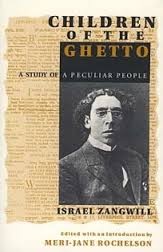
Children of the Ghetto blasted onto the literary scene in the year of a general election in which immigration was a hot political topic. Back in the early 1880s, there had been widespread sympathy for the plight of Jews escaping persecution and destitution, and large protest meetings in cities all over the country condemned the Russian pogroms. Soon, however, attention turned to the social impact of immigration. Spitalfields, often referred to as the ‘Jewish colony’, attracted the fascinated gaze of sociologists and journalists. ‘My first impression on going among them,’ wrote Mrs Brewer in the Sunday Magazine in 1892, ‘was that I must be in some far-off country whose people and language I knew not. The names over the shops were foreign, the wares were advertised in an unknown tongue, of which I did not even know the letters, the people in the streets were not of our type, and when I addressed them in English the majority of them shook their heads.’ Others reacted with antagonism rather than bewilderment. The anti-immigration campaigner Arnold White declared that, unlike Christian refugees to England, Jews formed ‘a community proudly separate, racially distinct, and existing preferentially aloof … A danger menacing to national life has begun in our midst,’ he warned, ‘and must be abated if sinister consequences are to be avoided.’
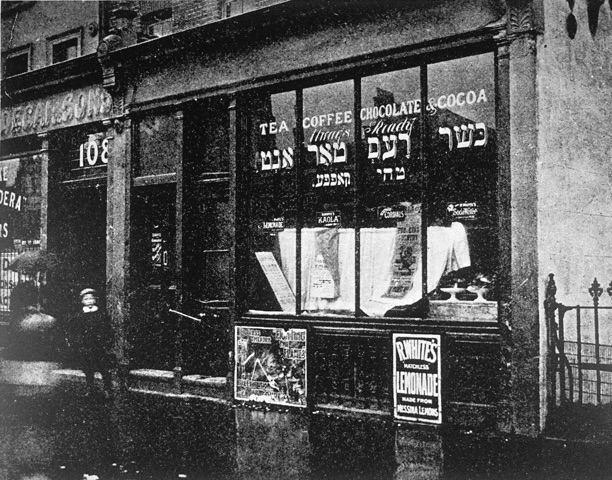
As with other immigrants before and since, the Jewish immigrants of the 19th century introduced new tastes and refinements to London.
By the early 1890s a group of Conservative back-benchers were increasing pressure on the government to control immigration. The failure of their efforts in the following years has been attributed by some to the impact of Children of the Ghetto. But rising unemployment and discontent at the end of the decade provided the opportunity for two East End Conservative MPs to form the British Brothers League, which aimed to galvanise local support. A mass rally in January 1902, held at the People’s Palace, Mile End Road, was advertised as a ‘great public demonstration in favour of restricting the further immigration of destitute foreigners into this country’.

The British Brothers’ League was formed in 1902 to campaign against immigration; it was organised on vaguely paramilitary lines. Dribbling into obscurity in 1923, the League was in many respects the precursor of the British Union of Fascists, which had a significant and unsavoury presence in the 1930s.
It was partly in response to this popular hostility that the first immigration restriction act for a century was passed in Britain – the Aliens Act of 1905. The Act, while retaining the right to asylum on political or religious grounds, gave government inspectors power to ‘prevent the landing of undesirable immigrants’, including ‘invalids’ and ‘paupers’ – those who could not show that they were capable of supporting themselves – and thus excluded not only the sick and elderly but also those who arrived destitute, often having been conned or robbed of their assets on the journey.
There are many resonances between popular anti-immigrant feeling then and now. In the early 20th century, it helped to channel and defuse Eastenders’ anger at their chronic poverty and insecurity. Jews were accused of lowering the standard of living with ‘sweatshops’ – small workshops characterised by poor working conditions, long hours, low pay and seasonal fluctuation, and of causing the housing shortage that had led to extreme over-crowding. Yet in fact both problems were rife in the East End long before the Jews’ arrival. Hostility to immigrants came from pervasive lack of understanding about the real economic causes of local unemployment, such as trade depressions, mechanisation, and competition from manufacturers in the provinces.
In this context, there was considerable pressure on Israel Zangwill to produce an uplifting account of Jewish Spitalfields, countering misconceptions and demonstrating how Jewish immigrants were contributing positively to the economy and living pious, law-abiding lives. That pressure is evident in aspects of the immigrant subculture that he deliberately left out of the novel: the gang violence, the prostitution, and gambling clubs.
Nonetheless, Zangwill took a bold stand against a number of contemporary stereotypes. Petticoat Lane market, for example, at the heart of the immigrant area, was invariably associated in the Victorian press with danger and dodgy dealing, but it has a very different meaning from Zangwill’s perspective. He describes Petticoat Lane as a place where Jews of all social classes congregate to experience the smells and tastes that remind them of their roots.
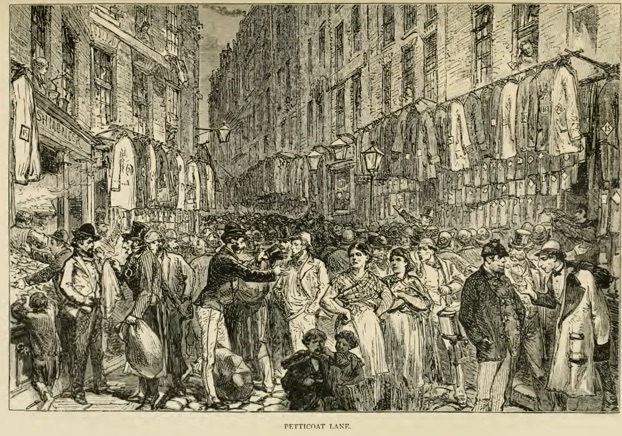
Petticoat Lane, 1878.
‘The Lane was always the great market-place,’ he writes, ‘and every insalubrious street and alley abutting on it was covered with the overflowings of its commerce and its mud … The famous Sunday Fair was an event of metropolitan importance, and thither came buyers of every sect … A babel of sound, audible for several streets around, denoted Market Day in Petticoat Lane, and the pavements were blocked by serried crowds going both ways at once.’ In his account of the market, Zangwill emphasises its vitality and vulgarity. The distinctive dynamism of immigrant culture, for him, was precisely what was valuable about it. But the market was far from being a ‘ghetto’: it was here that Jewish culture was shared with ‘buyers of every sect’. Unusually for a Victorian novelist, he regarded London’s multiculturalism as an asset to be prized.
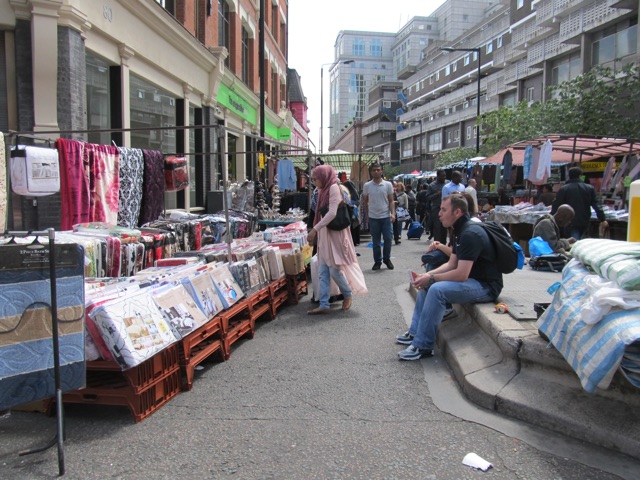
Petticoat Lane, 2015.
Zangwill also broke new ground in depicting the diversity of contemporary Jewish life. Although it would have been easier to advocate for Jewish immigrants by representing them as a cohesive community with shared needs and aspirations, he instead drew the novel’s dramatic scenes from the conflicts of class, religion and generation that fissured it. He intended, he wrote, ‘to exhibit clearly that the Jew, like the Englishman, cannot be summed up in any single, or indeed in any score, of types’. Children of the Ghetto explores divisions among Jews who are wealthy and poor, orthodox and secular, immigrant and English-born, men and women, parents and children. This was a fractured, deracinated population – uncertain of its future, at a moment of critical change.
It’s this complexity that I want to convey in Zangwill’s Spitalfields, a smartphone app that uses Children of the Ghetto as the basis for a walking tour of the Spitalfields area. The app brings to life the dilemmas that beset immigrants and their children in the context of fierce debates about migration from more than a century ago. Like the novel, the app’s narrative follows the story of Esther, a London-born ‘grandchild of the ghetto’, her routes between soup kitchen and school, attic home and marketplace and her changing relationship to Spitalfields. Many of the sites where Zangwill stages the novel’s key scenes are still extant, offering a series of physical settings where the app augments extracts from the novel with related visual and aural materials from the period. And I’m able to use the unique capacity of mobile digital technology to immerse the listener in Spitalfields’ past while remaining attentive, or becoming more attentive, to its present, as you walk through a streetscape shaped by more recent histories of migration.
Perhaps the most remarkable fact about Children of the Ghetto is that it became a bestseller following its publication and was repeatedly reprinted for several decades. Written in the context of widespread confusion about immigration, the novel opened up a little-known world to the reading public. But Victorian readers found more than novelty in its pages: they also encountered the story of a daughter rebelling against her father’s authority, a father striving to understand his son’s lack of interest in his family’s traditions, a woman longing for the warmth and security of her childhood home. Readers discovered that the struggles of Jewish immigrants in Victorian London were not so different from their own.
Nadia Valman is Reader in English Literature at Queen Mary, University of London. She researches and teaches the literature of east London, where she also leads guided walks. She wrote and curated the free downloadable smartphone app Zangwill’s Spitalfields.












